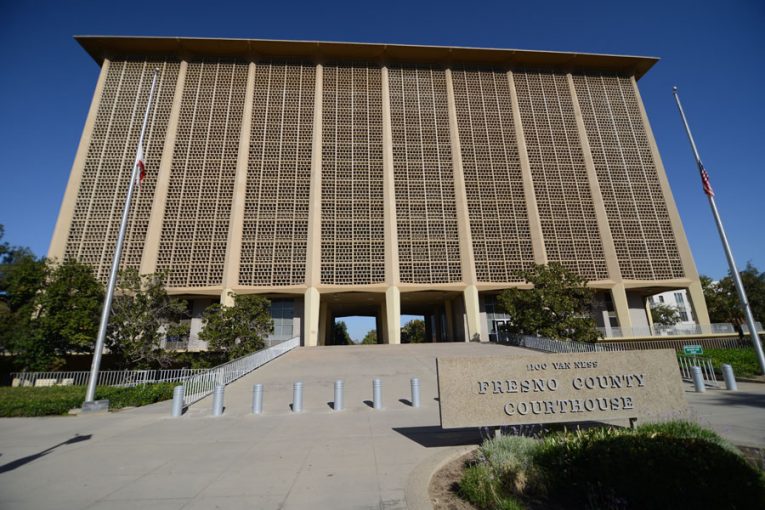
 By Natasha Feuerstein
By Natasha Feuerstein
FRESNO – A motion to suppress evidence in the questionable stop of an alleged reckless driver thought to be under the influence of alcohol was denied by Judge Samuel Dalesandro here in Fresno County Superior Court this week.
One California Highway Patrol security dispatch supervisor, and the two CHP officers who pursued the driver testified that just after 12:30 a.m. on Nov. 20, 2019, a 911 call was received that detailed a silver Chevrolet Avalanche with an unknown license plate traveling at high speeds all over the roadway in Fresno County.
The driver, and owner of the vehicle, was later identified as the defendant, Bounnhing Souvannavong, who was reported heading northbound on Highway 41 near State Route 99. The vehicle exited just before the officers took the same exit from the southbound direction.
Fresno Assistant Public Defender Emilia Carbajal questioned the dispatch catalogue’s likelihood of containing all of the 911 call’s information, and the ability of a 911 dispatcher to testify to what a caller actually said without an audio recording of the conversation.
“In that instance, it would take a lot longer to process the call if everything was typed verbatim from the caller, so we try to get the essential pieces of the information,” replied the dispatch supervisor, who said at approximately 12:38 a.m., the CHP unit positioned itself behind the vehicle at a stop light and ran a license plate number.
Officer Samuel Esqueda testified that he and his partner, Officer Jason Steinhauer, confirmed the vehicle was the same as the one called in by the reporting vehicle.
When Carbajal asked if Officer Esqueda noticed a pattern of driving that would allow him to believe the driver was intoxicated by some sort of substance, Esqueda replied that he “did not see any.”
Officer Steinhauer, however, testified that he and his partner did believe the driver was potentially under the influence of alcohol, based on their experience with reports of reckless driving.
Deputy District Attorney Cameron Simoes asked if Officer Steinhauer felt this was an incident the officers needed to pursue, and he replied that it was.
After observing the vehicle fail to immediately respond to the traffic light once it turned green for about three seconds, the officers made an enforcement stop, believing “at that time, to determine the level of sobriety from the driver, based on the 911 call.”
Carbajal noted that the officer deemed the failure of the defendant to immediately respond to the green light as an observation and not necessarily a violation.
“That can be a clue associated with drunk driving; it could also be inattention, cell phone use, or several reasons, but it is a reason for suspicion I have used throughout my career to identify impaired drivers,” said Officer Steinhauer.
“Personally, I would not solely stop a vehicle just based on that one three second observation,” he added, after Carbajal questioned whether or not his observation would render sufficient suspicion to stop the vehicle without the substance of the 911 call.
The defense claimed that nothing the defendant did would have led to reasonable suspicion without the information supplied by the person who reported “seeing something” in the 911 call.
Additionally, Carbajal argued the statements made by the reporting party were subjective, and claimed that since many of the details rested on the audio of the 911 call that was not made available to the court, there lacked sufficient evidence for probable cause.
The prosecution claimed that the enforcement stop was legal, and the statements were not testimonial.
“The officers testified to what they knew was a reckless driver. They were informed exactly where the defendant was, they went to that exact location, and were there to make sure an emergency was taken care of and to establish if the defendant was potentially driving under the influence,” Simoes maintained.
With this in mind, the officers had reasonable suspicion, Simoes insisted.
Judge Dalesandro denied the defense’s motion to suppress evidence, explaining that the dispatch report was not vague and instead able to lead the officers exactly to where the reporting party said.
He further explained that the statements made in the call were not testimonial. Based on the 911 call, the officers had reasonable suspicion to make an enforcement stop.
A preliminary hearing was set for later in February.
Natasha Feuerstein is a senior at UC Davis majoring in Political Science and minoring in Global Disease Biology. She is originally from Camden, Delaware.
To sign up for our new newsletter – Everyday Injustice – https://tinyurl.com/yyultcf9
Support our work – to become a sustaining at $5 – $10- $25 per month hit the link:
Drinking and driving is extremely dangerous keeping in mind that driving and using your cellphone is too so for using your cell phone to call 911 takes time and effort to report a drunk driving vehicle I know because I’ve witness one while driving Uber with both hands on the wheel I’m not always able to call fast enough even with using Bluetooth inside vehicle it’s a distraction from driving unless you have a passenger who is able too call it in with all the information. I hear it all the time on the scanner someone calling in on a possible drunk driver in the area and 9 times out of 10 the driver is not drunk and most likely the caller is in my opinion